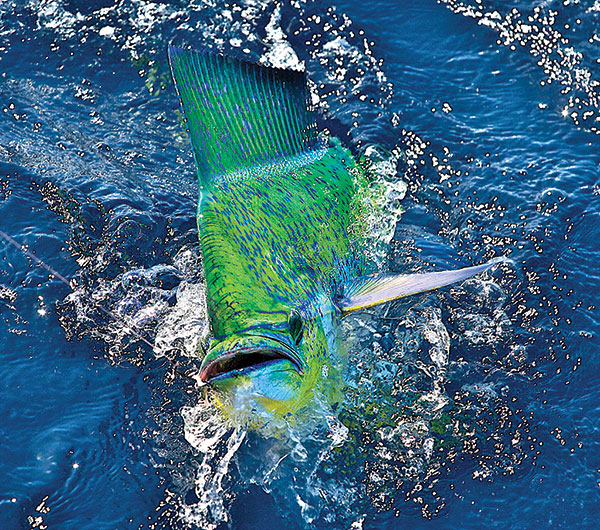
For years dolphin have been the Rodney Dangerfields on the blue-water stage. Despite powerful fights, amazing acrobatics, striking colors and tasty food value, they were often summarily dismissed by anglers pursuing billfish and tuna. Even their identity is muddled. Known as dolphin on the Atlantic and Gulf coasts, dorado in Spanish-speaking areas, and mahimahi in the Pacific, they grow quickly, range far, and are ideal sport. Big dolphin truly are trophies, and these three pros know how to catch them.
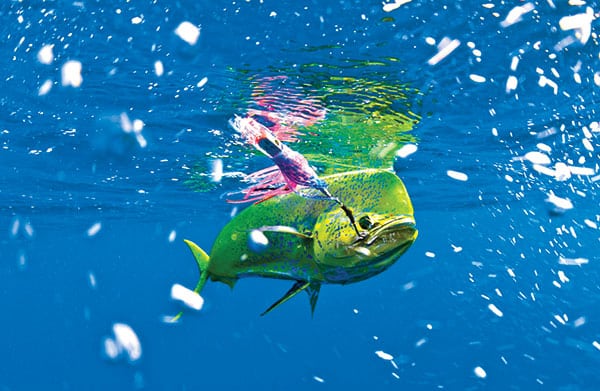
Keys Bull Wrangler
With his personal best a 68-pounder and multiple 50-plus-pound bulls to his credit, veteran charter and tournament skipper Capt. George McElveen has boated his share of big dolphin over the past 16 years. “You might catch one or two a year over 50 now if you’re lucky. Forty pounds is a big fish these days,” he says.
McElveen, who runs his 46 Markley The Reel McCoy out of Bud & Mary’s Marina in Islamorada, Florida, prefers to sight-cast dolphin with medium spinning tackle. The height advantage of his boat’s tower lets him spot big fish holding around weed lines or debris.
“Big fish put off a wake that you can often see from 100 yards away when it’s calm,” he says. “If the wind is blowing, we use frigate birds and terns to find them. There are also places here with rips that consistently hold flyingfish that attract big dolphin.” McElveen says the prime season for the Keys is May through July. In the early months, he focuses on depths of 400 to 600 feet. After the fish settle into their summer pattern, he ventures offshore as deep as 2,500 feet.
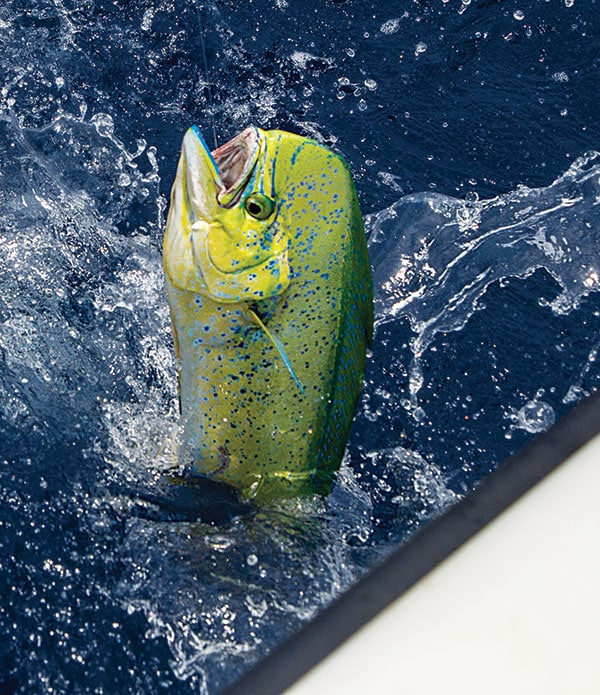
McElveen prefers to keep his tackle and presentations simple. In calm-water conditions when the fish are wary, a 20-pound spinning reel matched to a 61⁄2-foot medium-action rod does the trick. For more torque in rougher conditions, he’ll bump up to 30-pound outfits. He doubles the monofilament main line with a Bimini twist, and connects that 2-foot section to another 2-foot length of 50-pound Momoi mono leader with a double uni-knot or Albright knot for easier casting. A Mustad No. 7766, 5/0 hook with a uni-knot completes the rig. With 30-pound line, the leader is upped to 80-pound-test with a 7/0 hook.
“I’m a big fan of live bait, mainly pilchards,” he explains. “We run the hook through both lips so it won’t double back. I also like to twitch the pilchards so the fish hear and see it. That fires ’em up and triggers a strike. Fresh squid or chunks of bonito are other good baits.”
McElveen typically runs one plain ballyhoo off an outrigger as a Hail Mary offering while he searches. “If you see a couple of terns working an area, that’s a good sign for larger fish. Dolphin are pretty aggressive. If they’re going to eat, they normally don’t hesitate.”
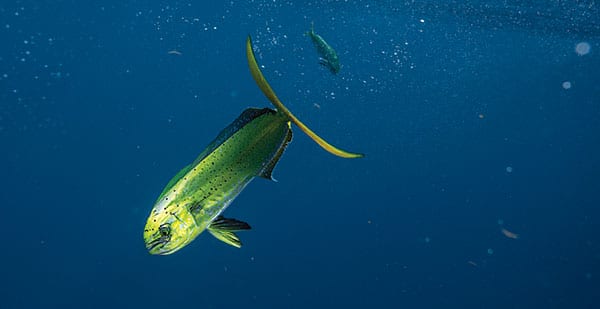
Cash Cow Catcher
Capt. Joey Birbeck has been working on private sport-fishing boats for the past 20 years, including 11 with the Chouest family, and more recently as skipper of You Never Know!, a 72 F&S and a Gulf of Mexico tournament fixture. You Never Know! won nearly $42,500 in prize money for a 47.8-pound dolphin boated during the 2009 Emerald Coast Blue Marlin Classic in Sandestin, Florida.
“We cover a lot of water in the Gulf, and generally we’re blue marlin fishing, but with the available dolphin prize money, we always have a rod ready and an assortment of live bait. We threw everything but the kitchen sink at that winning fish, and it finally ate a ruby-lip grunt. That’s why we carry a variety, including hardtails, mullet, croaker and grunts,” he says.
Birbeck’s favorite dolphin bait, however, is a butterflied ballyhoo with the backbone removed. “Give it a couple of jerks, and they’ll usually pile right on it.”
Birbeck makes a habit of investigating color changes and weed lines or patches of sargassum as he trolls for marlin. A squid daisy chain with a trailing Ilander-ballyhoo combo is his go-to teaser for big dolphin. From early May through June, fish-holding vegetation concentrates in the DeSoto Canyon. Whale sharks are another tipoff to trophy fish in the area, Birbeck says.
Birbeck and his mate, Stan Blackman, a Destin, Florida, native, also prefer a simple spinning rig for sight-casting; specifically, a medium rod and 6500 Thunnus reel loaded with clear 40-pound mono, tied to a swivel, followed by a 3-foot section of 50- to 60-pound leader with a corresponding hook to match the bait size.
“You want something you can wind to the rod tip and really whip,” Birbeck explains. “Stan grew up cobia fishing, so he can throw a bait through a trash can at 50 yards. We start with the ballyhoo, but if they’re finicky, we switch to the live bait. If we get the cow to bite, we wait for the bull to come back around to double our chances. We’ve put some serious coin in the bank with these tactics.”
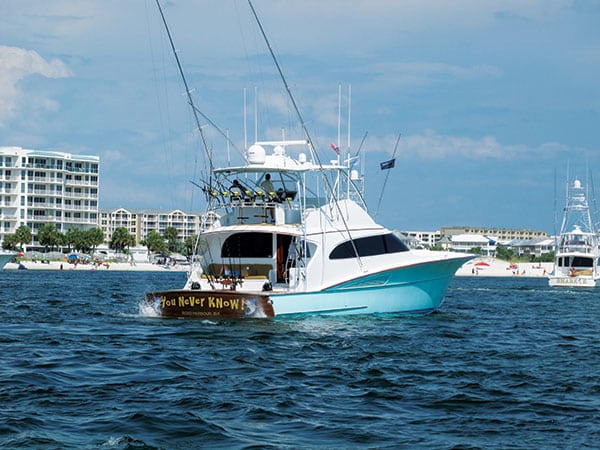
Baja Fly Wizard
Pamela Bolles runs Baja Big Fish Company in Loreto, Mexico, and she and her husband, Capt. Francisco Muñoz Tenorio, are both avid anglers. Their favorite way to catch bragging-rights dorado? With the fly rod.
“Francisco and I are tied for our personal best at around 45 pounds … so far,” she says with a laugh. “A client, Dr. Donald Childress, caught one that weighed 57 pounds, 8 ounces on 20-pound-class tippet that has held as a world record since 1997. We prefer fly-fishing over any other method.”
For fly tackle, Bolles recommends a 10-weight rod matched to a large-arbor reel with a good drag and a capacity of 250 yards of 30- to 50-pound backing. She likes a Teeny TS-450 fly line attached loop-to-loop to the backing. An Albright knot connects the monofilament butt section (30- to 50-pound-test) that terminates in a double surgeon’s loop for quick leader changes. The rig is completed with 6 feet of 12- to 30-pound mono tied with either a simple clinch or perfection loop to the fly. Since Bolles doesn’t fish for IGFA records, she forgoes a class and bite tippet.
“If you want a good challenge, fish dorado with an 8-weight outfit, but use a light leader and loose drag,” she says. “Sometimes the dorado are very picky and leader-shy, so that’s when I scale down in size. The key is to loosen the drag almost all the way, and brake with your palm.”
Bolles and her guides use pangas in the Sea of Cortez, looking for currents, weed and scum lines, floating debris, and frigate birds to pinpoint the dorado. Dependable indicators include flyingfish, water temperature and color breaks. Once they have located the fish, she uses live chum to entice strikes, throwing Pacific flatiron herrings, known locally as sardinas, into the strike zone before she casts the fly.
“The flies I use for dorado are Bull Clousers and Bull Candy with size 2/0 hooks,” she says. “I like olive-and-white and tan-and-white patterns. I also take poppers in blue-and-white on 2/0 hooks. I bring five rods on board with me, each rigged with one of these flies, so I’m always ready.”









